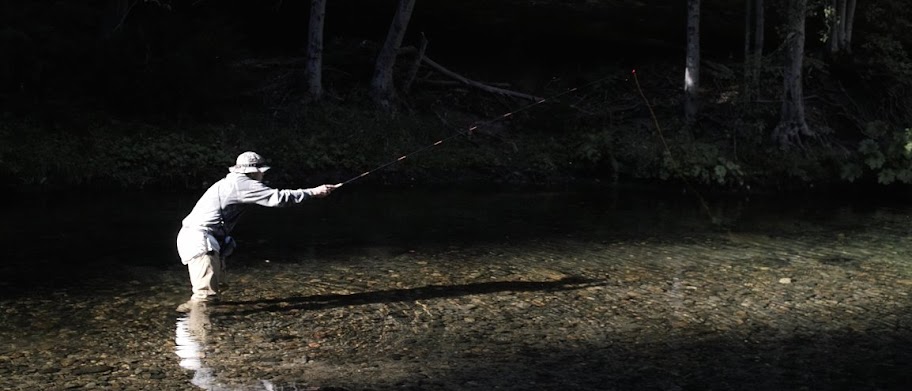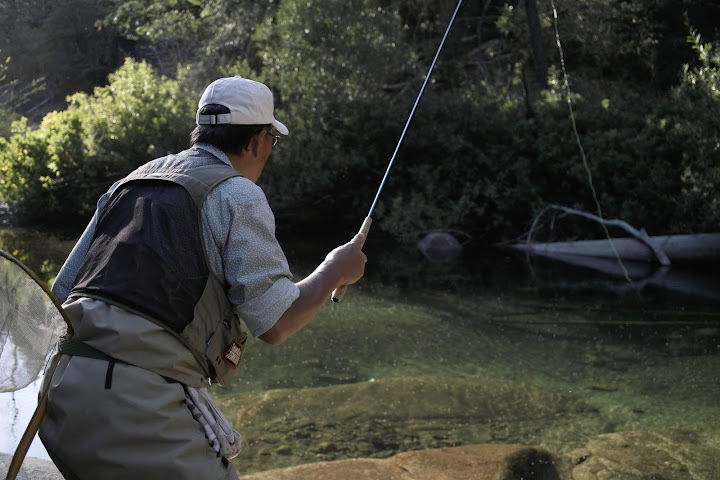Archive for February 2011
Tenkara Summit
First “Tenkara Summit” : August 27th, West Yellowstone, MT! Read the rest of this entry »
Please visit www.tenkarausa.com
.
.
.
.
Please visit: Tenkara USA for fresh blog updates.
.
.
.
.
.
This blog is just a testing ground for Tenkara USA’s main blog.
Upstream or Downstream? One more point Angler Etiquette
The last post was based on the long-held discussion of whether it’s better to fish upstream or downstream. Thinking about it, made me discuss a few pragmatical reasons to fish upstream. I decided to ask Dr. Ishigaki why he likes fishing upstream, looking for more “scientific” reasons. But, instead I was reminded of an important reason that I missed: angler etiquette!
When we go fishing in a mountain stream, we are often looking for solitude. Not only that, but fish in smaller streams will often be spooked more easily and not take a fly if they have been disturbed. So, keeping other anglers in mind, as well as our own interest, the best approach is to have every angler fish in the same direction, upstream. This will ensure that anglers are not crossing each other, just to find the entire rest of the stream spoiled. It will also allow anglers to leapfrog each other if they see someone upstream.
I grew up surfing, and though I won’t discuss the etiquette of wave riding, and surfers tend to be quite different when it comes to protecting their water, they do understand clearly that some etiquette in the water benefits everyone. Sure, there are wave hogs, and most breaks are way more crowded than any stream I have ever fished, but everyone moves in one general direction and that helps keep people happy in the water.
Fishing upstream or downstream? The long-standing question from a tenkara perspective
Many times inspiration for our blog posts comes straight from the great community of tenkara anglers hosted in our forum. In recent days two threads were posted in our forum related to the idea of fishing upstream or downstream: “How do you prefer to fish with tenkara- upstream or downstream?” The forum threads are great because they present questions many of us ponder, but perhaps don’t bother thinking much about. They usually force me to think of “why”, sometimes providing some new insights. This post is basically my answer to how I tenkara fish, and why I fish upstream. Answering it made me realize that, even though there is a long-accepted theory that fish can see better if you approach them from upstream (that is, fishing heading downstream), I really don’t buy into it, but rather, fish upstream because of a couple of more practical reasons.
I think there may not be a wrong direction to fish as long as the approach is well planned, but as I will write below, I think fishing upstream has at least three advantages: (1) a good chance of not being seen by fish if you’re in a steeper tumbling stream, (2) greater ease at spotting stream features, and (3) a larger number of presentation possibilities.
A couple of weeks ago I went fishing with Ralph and Lisa Cutter, very well known and respected anglers. They own the California School of Fly Fishing. Ralph is most well known for his underwater studies of fish and bugs – he dives a lot and, with his years of research and experiments, knows what fish can or can not see. He said he always prefers to fish downstream. I brought up the idea, which I don’t personally buy too much, that fish would be able to see you more easily this way; he said that’s nonsense, fish have an almost 360′ field of view, with a very small blind spot directly behind them, but as they are constantly moving, swinging with the current, their actual field of view is 360′. The reason he likes to fish downstream is a practical one: he says he is a very visual angler, and can see the white in a fish mouth more easily that way and thus strike the hook when that happens.
Fishing downstream, features are harder to spot
I may understand the field-of-view reasoning for slower moving streams and flatter streams. However, when fishing in a steeper stream, even if fish may have a 360′ fov, one advantage of fishing upstream is using the geography of the stream to help hide you. In a steeper stream, it can be common to find large rocks upstream, and the natural “falls” and turbulence of the water can do their part on this too. On the same token, I think it is much easier to see features in the water when you’re moving upstream. if moving downstream all can blend in a bit more easily, features become “flatter” as the boulder breaking water above a spot will now hide it, you can’t see the whirlpool forming so well because the water dropping into it may be hiding it. I haven’t taken pictures with this in mind, but above this paragraph is a picture of a stream looking downstream on it. To me it looks relatively flat, and though I can’t see places where fish may be hiding, I can’t see them all that well. The picture below shows the contrasting image, the same stream but looking upstream, you can see a lot of features that may be holding fish. Not to mention that if you’re wading downstream, you could potentially step into a deeper pool without noticing it, but that is more easily avoided if moving upstream.
Fishing upstream reveals the stream features more clearly
My tenkara sensei, Dr. Ishigaki prefers to head upstream. I haven’t asked him exactly the reasons why he does so but will in my next email. He never fishes moving downstream. BUT, he frequently does fish straight across, and occasionally a little downstream too if he finds the need to, as he moves upstream. Because he prefers fishing upstream, his first casts will almost always be upstream. As he moves up he will often hit the same spot from two, sometimes three different directions if he believes there are fish there: so, upstream, 1/4, straight across. You can see a summary and illustrations of the main tenkara techniques in our past blog posts.

His general approach, and mine is: keep moving upstream, because we’re moving up our first casts will almost always be about directly upstream, with a drag-free drift of the fly. If there are features (small whirlpools/currents/etc) 1/4 upstream, then cast to those too. Try 3-4 casts in each of these directions. Now, you move up and the pool that used to be upstream or 1/4 upstream from you is straight across and you can try fishing that spot for a totally new angle and with new technique. By casting straight across you can manipulate the fly in different ways (stop the fly, let it drift, stop, let it drift; or stop, pick up, stop, pick up; or casting slightly downstream and move the fly upstream about 1ft at a time by pulling it. If you effectively covered the water on your way up, there shouldn’t really much of a need to fish downstream as the water has been covered.
Now that I write this I realize another reason to fish upstream may be that, with all things being equal – e.g. fish can see you well no matter which directions – by moving upstream you can hit the same spot with more fly manipulations/techniques.
If you move down stream, you can hit the pool downstream with essentially one presentation: stop, let it drift or any variation with drag, it’s difficult to achieve a drag free presentation this way without creating slack in your line; then as you move to the side of the spot, you can get a drag free drift but maybe not a great one; at this point it is no longer very effective to go downstream from the spot and try another presentation if the fish hasn’t striked, and you missed a chance to get a good drag-free drift over that spot. But, by moving upstream, I think you can get the drag-free drift first, and apply all other techniques effectively from the side of the spot, and perhaps a little upstream from it. So, you have now applied one extra, perhaps the most effective, technique.
Tenkara reaches Finland Interview with Tenkara USA founder
Finnish blogger and ultralight backpacker Hendrik Morkel, of the site “Hiking in Finland”, conducted a good interview with Tenkara USA founder, Daniel Galhardo (yes, that’s me, and another “ego boosting” intro 🙂 ). The interview covers several aspects of tenkara, and also focuses on the business side of Tenkara USA, and the vision behind it.
Excerpt:
Interview: Daniel Galhardo from Tenkara USA
“I love angling. I love Japan. So when I read about two years ago about Tenkara USA I knew immediately that it is something I need to try. Since then, I fished a few times with my tenkara fly fishing gear, and have kept a steady eye on the developments of the company. I always liked them, great videos, great website, great service. So I got in touch with the founder of Tenkara USA, Daniel Galhardo, and he happily agreed to an interview. If you’re not yet hooked on tenkara [pun intended], I bet you will be after this interview – enjoy!
Most current picture of Tenkara USA’s headquarter:

To read full interview, please visit Hiking in Finland

